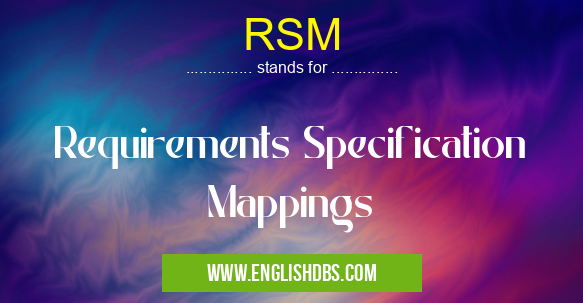What does RSM mean in UNCLASSIFIED
RSM (Requirements Specification Mappings) is a crucial practice in software engineering that establishes a clear connection between requirements and the corresponding test cases or design elements. This mapping ensures that every requirement is accounted for and verified during the development and testing phases.

RSM meaning in Unclassified in Miscellaneous
RSM mostly used in an acronym Unclassified in Category Miscellaneous that means Requirements Specification Mappings
Shorthand: RSM,
Full Form: Requirements Specification Mappings
For more information of "Requirements Specification Mappings", see the section below.
What is RSM?
RSM involves creating a structured document that maps requirements to specific test cases or design elements. This document provides a traceability matrix that allows stakeholders to track how each requirement has been implemented, tested, and verified. By establishing this mapping, RSM ensures that:
- All requirements are addressed: Every requirement is mapped to at least one test case or design element, ensuring complete coverage.
- Test coverage is comprehensive: Test cases are designed to verify all aspects of the requirements, ensuring that the software meets its intended functionality.
- Traceability is maintained: The mapping document provides a clear trail of how requirements are translated into testable specifications and design elements.
Benefits of RSM
- Improved quality: By ensuring that all requirements are addressed and tested, RSM helps to improve the overall quality of the software.
- Reduced defects: Early detection of missing or incomplete requirements reduces the likelihood of defects in the final product.
- Enhanced collaboration: The mapping document facilitates communication between stakeholders, such as requirements engineers, testers, and developers, by providing a shared understanding of the requirements and their implementation.
- Simplified maintenance: The traceability matrix simplifies maintenance efforts by allowing changes to requirements to be easily tracked and updated in the test cases and design elements.
Essential Questions and Answers on Requirements Specification Mappings in "MISCELLANEOUS»UNFILED"
What is Requirements Specification Mappings (RSM)?
Requirements Specification Mappings (RSM) is a process that establishes traceability between requirements and other project artifacts, such as design documents, test cases, and source code. This mapping helps ensure that all requirements are accounted for in the project's design and implementation.
Why is RSM important?
RSM is important because it helps to:
- Ensure that all requirements are accounted for in the project's design and implementation
- Trace requirements to specific project artifacts, making it easier to track changes and updates
- Identify and resolve inconsistencies between requirements and other project artifacts
- Improve communication between stakeholders by providing a common understanding of the project's requirements
What are the benefits of using RSM?
The benefits of using RSM include:
- Improved project quality
- Reduced risk of defects
- Increased customer satisfaction
- Improved communication between stakeholders
How do I implement RSM in my project?
To implement RSM in your project, you will need to:
- Identify the project's requirements
- Create a mapping between the requirements and other project artifacts
- Maintain the mapping throughout the project's lifecycle
Final Words: RSM is a valuable practice that plays a vital role in ensuring the quality, completeness, and traceability of software requirements. By establishing a clear mapping between requirements and test cases or design elements, RSM improves collaboration, reduces defects, and simplifies maintenance efforts. As a result, software engineering teams can deliver high-quality software products that meet the needs of end-users.
RSM also stands for: |
|
| All stands for RSM |
